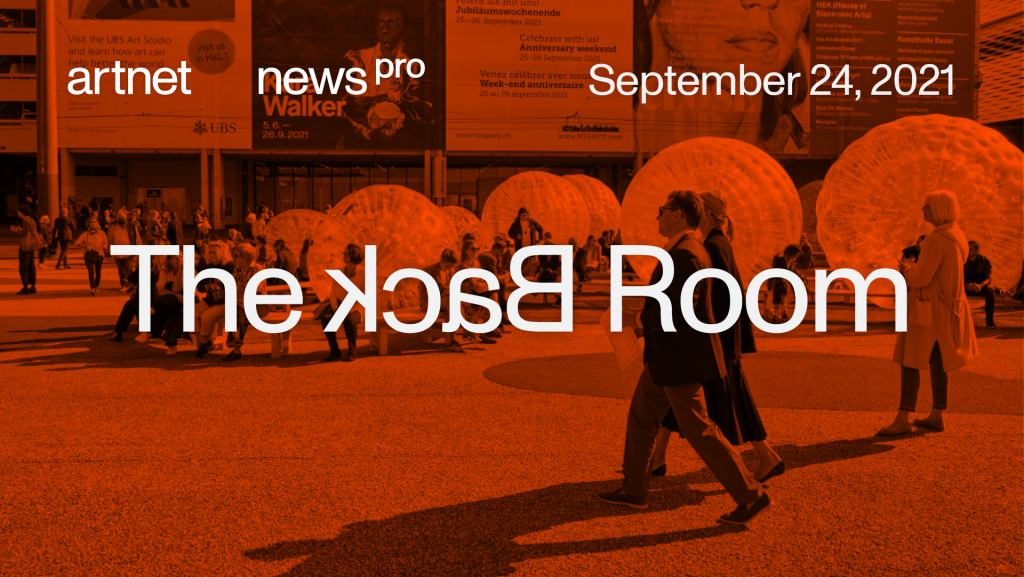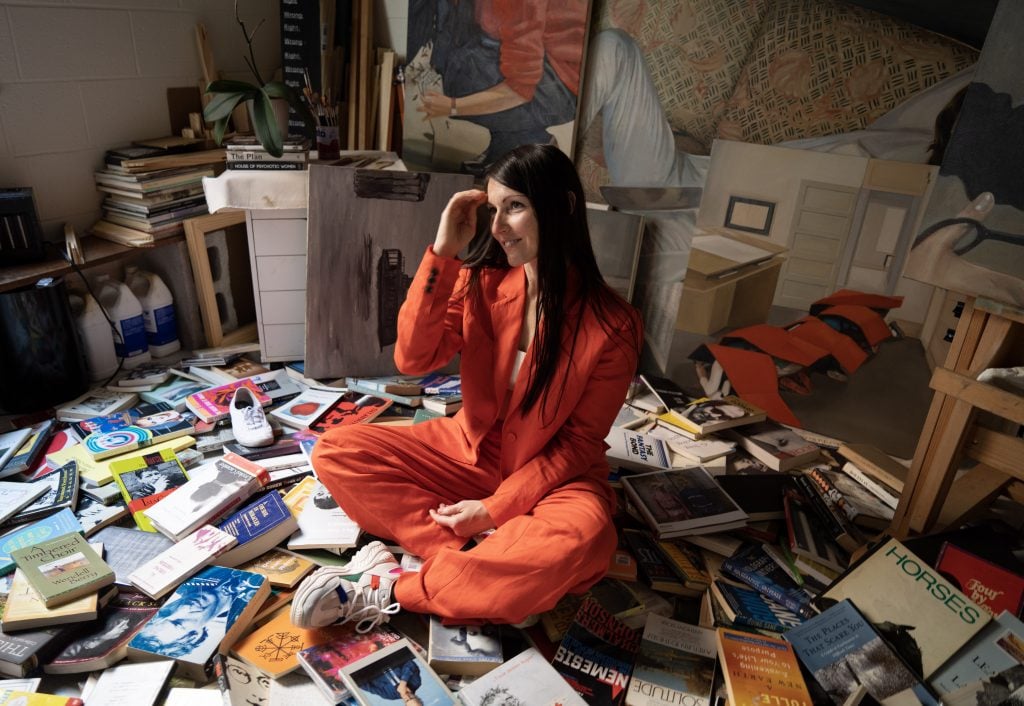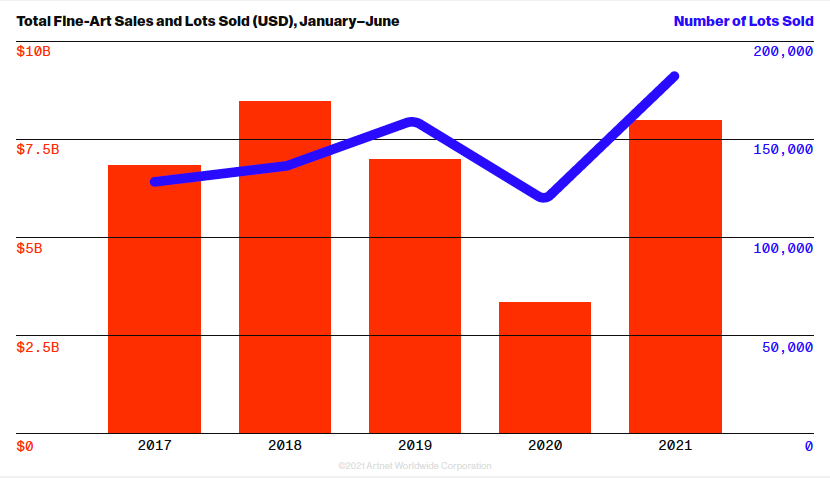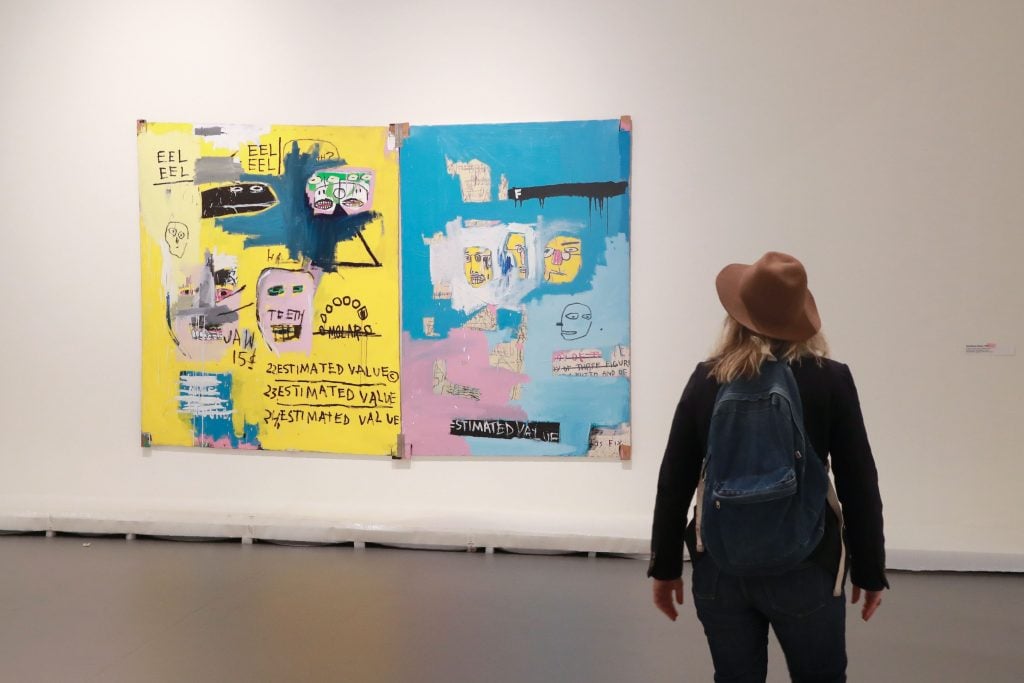The Back Room
The Back Room: A Post-American Art World?
This week: Euro buying boosts Basel, the young artist with a 196-strong waitlist, the global market’s first-half rebound, and more.

This week: Euro buying boosts Basel, the young artist with a 196-strong waitlist, the global market’s first-half rebound, and more.

Tim Schneider

Every Friday, Artnet News Pro members get exclusive access to the Back Room, our lively recap funneling only the week’s must-know intel into a nimble read you’ll actually enjoy.
This week in the Back Room: Euro buying boosts Basel, the young artist with a 196-strong waitlist, the global market’s first-half rebound, and much more—all in an 7-minute read (2,064 words).
__________________________________________________________________________________

Caroline Mesquita at Union Pacific. © Art Basel
After what sometimes seemed like more eleventh-hour drama than a New Year’s Eve party attended solely by couple’s therapy dropouts, Art Basel’s flagship fair indeed returned to the Messeplatz this week. The event has proven to be a mix of comfort food and novelty for the post-vaccine art market.
The big story from opening day was the meager number of U.S. collectors who made the trip. European buyers dominated the aisles to an extent unseen in many years, with VIPs like Guillaume Houzé, Walter Vanhaerents, Füsun Eczacıbaşı, Francesco Taurisano, and Anita Zabludowicz all present.
Yet sales at the fair have been healthy anyway, albeit with two potential asterisks further separating this year from the Basel norm: apex-level dealers seemed to bring somewhat more conservatively priced fare, and preselling seemed to approach an all-time high.
Still, partly thanks to demand from international collectors and advisers participating remotely, top-end deals called out from the fair’s main section included…
Art Basel Unlimited moved units too, in no small part because big paintings had a bigger presence than usual. (The high contrast was all the more reason Urs Fischer’s literal Bread House, installed by Jeffrey Deitch, sopped up so much attention ahead of the section’s opening.) Payouts made for the giants on opening day included…
Another 2021 change-up: Art Basel also introduced its audience to (you guessed it) NFTs. More accurately, the shepherds were the folks at Galerie Nagel Draxler, who collaborated with the participating artists and curator Kenny Schachter to make their booth’s back room into an eye-catching physical addendum to their recent exhibition “NFTism.”
Along with plenty of attendance and curiosity on opening day, sales for editions included…
All NFT acquisitions were supposed to be made in cryptocurrency on the OpenSea marketplace, but Nagel Draxler wisely made a few exceptions on the fair floor. With the artists’ sign-off, the gallery invoiced collectors for old-fashioned fiat currency, purchased the works with its own crypto wallet, and agreed to transfer them to the end client upon payment.
As always in the art market, where there’s a will, there’s a way…
__________________________________________________________________________________
Compared to Art Basel 2019, when David Zwirner led the sales pack by placing a $20 million Gerhard Richter, even the priciest transactions at this year’s edition of the fair feel uncharacteristically approachable.
At the same time, gallery-sector deals above $1 million are objectively good outcomes almost anytime and almost anywhere—but especially after the exhibitors, artists, collectors, suppliers, and Basel staff had to white-knuckle their way through the Delta variant demolition derby to ensure the live fair happened at all. Even more important to the ecosystem are the abundance of sales in the five- and six-figure ranges reported by galleries showing in the fair’s more earthbound reaches.
So it seems the gain for many exhibitors was worth the pain. But for now, the only people who will know for sure are the galleries themselves, the fair execs responsible for wooing them back next year (if not to Miami Beach in two months), and the independent auditor administrating Basel’s one-time solidarity fund, whose CHF 1.5 million ($1.6 million) participating galleries can tap into to offset their costs starting this Monday. Those are all stories yet to be told.
__________________________________________________________________________________

Shannon Cartier Lucy. Photo: Matt McKnight
This week, Wet Paint sketched out the burning market for Nashville-based artist Shannon Cartier Lucy, whose just-opened show at Lubov Gallery in New York was crammed with heat-seeking art heads—and who has amassed a waitlist of 196 names for the six available paintings there, according to Lubov founder Francisco Correa Cordero.
Early patrons of the artist’s work (with an aesthetic once described as “Norman Rockwell meets David Lynch”) include Massimo De Carlo partner Alberto Chehebar, a senior director of Hauser & Wirth, and even a former Playboy bunny. Her primary-market prices have swelled from $7,000 in 2019 to a minimum of $30,000 today, Correa Cordero said.
Demand from the sell-side is growing, too. Sources say Cartier Lucy already turned away an offer from White Cube for a solo OVR last summer, as well as an overture from “at least one prominent downtown New York gallery.” And while her work hasn’t yet appeared at auction either, it’s only a matter of time before the first flipper makes their play.
Here’s what else made a mark around the industry since last Friday…
Art Fairs
Auction Houses
Galleries
Institutions
The National Gallery in London tapped venture capitalist, philanthropist, and Tory backer John Booth to be its new board chair. Despite Booth’s long track record of cultural patronage, his political affiliation has rekindled accusations that Boris Johnson is loading the country’s institutions with conservative leaders.
NFTs and More
__________________________________________________________________________________

© 2021 Artnet Database and Artnet Analytics
Sales of fine art at auction have been just as boisterous as sales at art fairs in the first half of 2021, if not even moreso. The houses moved $7.8 billion worth of fine art from January through June—138 percent more by value than the equivalent period last year, and 12 percent more than the same frame in the blissful pre-social-distancing ignorance of 2019.
The results by volume were even more impressive. A staggering 181,438 fine-art lots changed hands in the opening six months of this year, the highest number since the art auction market’s all-time peak in the mid-2010s.
What’s behind the ascent? For the answer to that and more questions about the art market in 2021—as well as the rest of this decade—download the newest issue of the Artnet News Intelligence Report below.
__________________________________________________________________________________
“In previous years, there were so many ‘first choice’ VIPs here in order to create an artificial sense of crowd to make you buy faster… Now it’s just the real people who are interested. We have fewer Americans, which means we can have more discussions because, as you know, the Americans are just asking for prices and then they do a deal.”
—Belgium-based collector Alain Servais on what he saw as the uncharacteristic experience of VIP preview day at Art Basel 2021. (Not everyone agreed with his take.)
__________________________________________________________________________________
The Whitney Museum of American Art is “considering the sale of” the Breuer Building, the Madison Avenue architectural landmark it called home for almost a half century, according to reporting by my colleague Katya Kazakina. (Artnet News Pro)
The “saved you a click” summary:
__________________________________________________________________________________
Artistate, a new business aiming to help artists get their affairs in order well before their twilight years, has emerged from the hive mind of a dealer, an accountant, and a pair of lawyers. (The Art Newspaper)
__________________________________________________________________________________
Artists are increasingly funneling their anger, frustration, and/or fear about the climate crisis into works for art fairs, defying the “safe, easy, and sellable” ideal of expos. (Artnet News Pro)
Among searches of the Artnet Price Database in August, the fastest-rising artists included Rubell residency alum Allison Zuckerman, curiously resurgent Zombie Formalism survivor Angel Otero, and (checks notes) Spanish painter of bike-riding mice Edgar Plans? (Artnet News Pro)

Jean-Michel Basquiat’s Hardware Store (1983), on view at the Fondation Louis Vuitton in Paris. Photo: Jacques Demarthon/AFP via Getty Images.
__________________________________________________________________________________
Date: 1983
Seller: Van de Weghe
Price: $40 million
Selling at: Art Basel, Galleries Section
__________________________________________________________________________________
Despite the (relative) conservatism shown by many of his fellow exhibitors, Christophe Van de Weghe is shooting for the moon at Art Basel. The gallery’s booth features Hardware Store, a monumental Jean-Michel Basquiat painting hitting the secondary market for the first time with a $40 million ask that puts it near, if not at, the fair’s price pinnacle this year.
Among the artist’s largest cross-bar diptychs (at roughly 7-by-11 feet), Hardware Store features one yellow and one blue canvas overlaid with his signature scribbled heads, skulls, and evocative phrases like “estimated value” and “eel.” The painting has remained a part of the same private collection since its completion almost 40 years ago. So who is the owner? Van de Weghe is staying mum, but there are breadcrumbs in the public domain.
Hardware Store has been lent to two high-profile Basquiat shows at institutions: the Whitney‘s in 1992–93, and the Fondation Louis Vuitton‘s in 2018–19. While a 2010 Basquiat monograph credited its owner only as a private collection, the photo appeared courtesy of Galerie Bruno Bischofberger, which represented JMB for all six years between his 1982 departure from Annina Nosei Gallery and his death in 1988. More tantalizing, the Vuitton catalog identified the work’s lender as the Bischofberger Collection of Männedorf-Zurich. So, we can’t say for sure who consigned it to Van de Weghe, but… uh, I know what my guess would be.
“This painting has amazing visual power,” Van de Weghe said. “I convinced the owner, who is a good friend, that now is the time to sell.” Whether or not he was right remains to be seen; an inquiry about the piece’s availability was unanswered by Thursday evening.
__________________________________________________________________________________